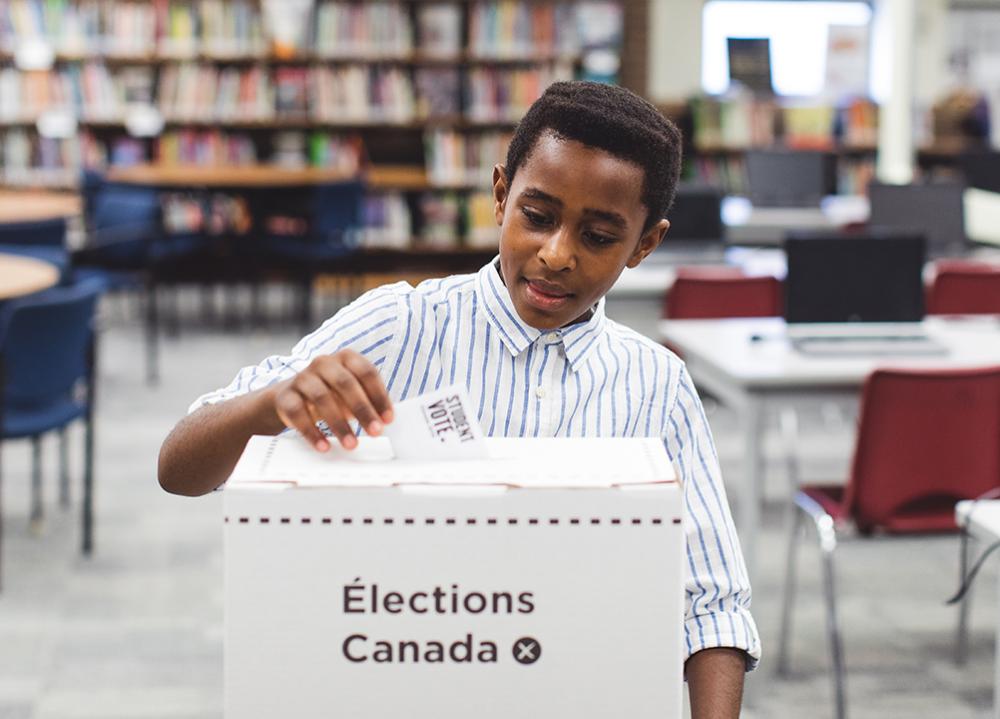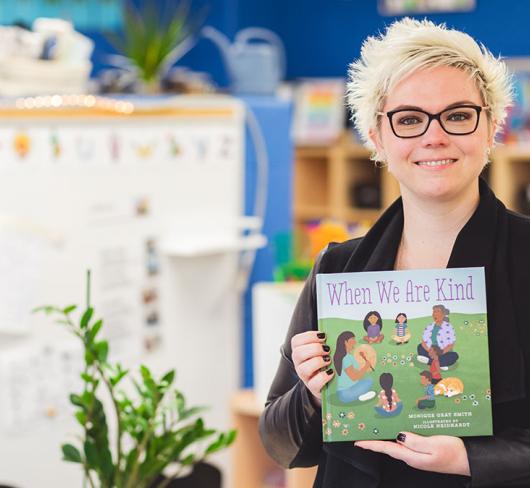
Learning How to Calculate 'Fair,' Democratically Speaking
The majority status of Ontario’s PC government has given it licence to execute regressive cuts that impact every public sector. Studying voter representation from a mathematical perspective inevitably leads to astonishment: how can first-past-the-post (FPTP) be considered “fair” when, under that system, the majority of votes don’t count? Isn’t there a better way? Middle school students are only two elections away from being able to vote, and yet data from past elections tell us that many are not likely to do so. Might they be more likely to vote if they knew their vote would count?
Developing thoughtful, active citizens is one of my primary goals as an educator, and so I work to integrate citizenship education into my teaching across the curriculum. Last year, our school explored electoral democracy in the lead-up to the provincial election. My math class considered the merits of different electoral systems and our Student Vote Committee organized a citizens’ assembly, an all-candidates’ debate and a Student Vote parallel election.
In the weeks before the election, my grade 7 math class learned about the voting process. I introduced the class to the first-past-the-post voting system, which most Canadian jurisdictions use, in our study of rate, ratio and percent. We began with a simple analysis: in a riding of 10 people, if three people vote for Candidate A, three people vote for Candidate B and four people vote for Candidate C, then Candidate C wins the seat, despite the fact that 60 percent of voters did not vote for them. Students were outraged to discover that under FPTP, we often elect a powerful majority government, even when the majority of voters don’t choose that party. In our math class, we explored the idea of “proportionality,” and students concluded that in a government that is proportionally representative of voters, the ratios of the seats in parliament should be equivalent to the ratios of the votes cast.
In the 2018 provincial election, Doug Ford’s PC Party was elected as a majority government despite having only 40.5 percent of the popular vote. Almost 60 percent of voters did not choose a Conservative candidate, and yet the Conservatives still won a majority with 61 percent of seats. As a result, they have brought in sweeping changes to healthcare, drastic cuts to public education, cancelled cap and trade, eliminated increases to the minimum wage and removed enhanced protections for vulnerable workers. They have cut over 700 green energy projects and cut Toronto city council in half. And these are just a few of their regressive initiatives. In addition, the government cancelled a curriculum-writing session mandated by the Truth and Reconciliation Commission, which would have updated the provincial curriculum with Indigenous content. At our school, the Ford cuts reduced the teaching staff by almost 40 percent, despite an increase in enrolment. These drastic measures would not have been possible if the PC Party had only won the number of seats proportional to their share of the popular vote.
In math class, students also realized that the government better represents the citizens when more people vote. However, they learned that under FPTP, many voters feel obliged to vote for someone other than their first choice in order to be strategic (so the person they don’t like won’t win), and some are so frustrated by having their votes “wasted” that they stop voting altogether.
In anticipation of last year’s provincial election, students formed a Student Vote Committee to organize a CIVIX Student Vote at our school. CIVIX is a non-partisan organization with a mandate to promote citizenship among young Canadians by running elections for students parallel to municipal, provincial and federal elections. For this election, our committee was interested to see what would happen if students used a different voting model than FPTP. They watched electoral reform advocate Dave Meslin’s creative analysis of FPTP in which he used Lego to make a 3-D graph of outcomes under different voting models. In his analysis, when asked which alternative to FPTP Canadians should use, Meslin said that the best way to choose a model would be to put the question to Canadians in a citizens’ assembly. The Student Vote Committee decided to follow his advice, so they organized a citizens’ assembly at our school.
Students on the committee divided themselves into three groups. Each group was tasked with learning about a different voting model. They learned about first-past-the-post, mixed member proportional and ranked ballot. At the Citizens’ Assembly, the groups presented the three systems to their peers, who ultimately decided that ranked ballot was the fairest system. Since they were participating in the CIVIX Student Vote, which was using FPTP, they decided to run two parallel votes: the “official” one using FPTP, whose results we would submit to CIVIX, and their own “unofficial” vote using a ranked ballot.
In the lead-up to the election, the Student Vote Committee created posters for each major candidate in our riding outlining the platform ideas of each party. They decided to host a debate, and the committee members contacted the candidates and invited them to attend. Students submitted questions, and the Question Selection Sub-Committee chose the most appropriate questions to put to the candidates. The Student Vote Committee used the CIVIX guide to help organize the debate. They were very excited on the day of the debate and took their roles very seriously. The committee set up the gym, and then grade 4-6 students from our host school and all of our students entered the gym. Student greeters welcomed the candidates and showed them to their seats on the stage. The debate began with candidates’ introductions, followed by moderated questions. The candidates listened to the students’ questions carefully and responded thoughtfully to each one. After the pre-selected questions were answered, we opened the floor to questions from the audience. Dozens of eager hands went up, as students vied for the opportunity to put a question to the candidates. The conversation was lively, and the candidates engaged passionately with the topics. The students were mesmerized, and disappointed when we had to end the debate despite many unanswered questions. At the end of the debate, a student thanked the candidates for coming. As another said afterward, “I thought the debate went really well, and personally it helped me choose who I was going to vote for, because at first I wasn’t sure if Party A or Party B was my first choice and the debate helped me figure it out.” Organizing and running a debate with actual candidates gave the students a sense of legitimacy and agency as participants in the democratic process.
On the day of the election, the Student Vote Committee was very excited. A classroom was set up as the polling station with student poll clerks crossing students’ names off the voters’ list when they came in and handing them two ballots: the conventional ballot provided by CIVIX, and our own ranked ballot. Students put the conventional ballots into the “official” ballot boxes, and the ranked ballots into boxes that students had created with an alternate design. After all the students voted, the committee opened up the boxes and counted the ballots. One student called out the results, and scrutineers monitored the count.
The members of the committee were surprised by the results. In the FPTP vote, Marit Stiles (NDP) won with 23 of 48 votes (48%). In the ranked ballot vote, round 1 (counting first choices) put Kirsten Snider (Green) in first place, but without a majority. Round 2 still didn’t yield a majority candidate, and it wasn’t until round 3 that a candidate had a majority – it was Dave McKee of the Communist Party. The Student Vote Committee was struck by how different the ranked ballot results were from the FPTP ballot.
Students reflected thoughtfully on the “adult” election, in which Doug Ford’s Conservative Party was elected as a majority government with a minority of the popular vote. Far from being discouraged by the outcome, the results buoyed the Student Vote Committee in their commitment to fair voting and the democratic process. When asked about her overall reflections on the Student Vote process, one student wrote, “I thought that it was really amazing to do our own election, and to have students vote on what type of ballot to use. Some people in the actual election might vote differently because of how first-past-the-post works, but when we used ranked ballot, they could vote for their actual first choice because the candidates have a chance to win.”
If we consider the outcome of the 2018 provincial election, we can see that if we had used a system like mixed member proportional (MMP), the outcome would have been different. Under MMP, the PC party, with 43 percent of the vote, would have had only 53 seats (instead of 76); the NDP, with 35 percent of the vote, would have had 43 seats (instead of 40); the Liberals, with 19 percent of the vote, would have had 23 seats (instead of 7); and the Green Party, with 4 percent of the vote, would have had 5 seats (instead of 1). These results more closely match the popular vote, and moreover, Ford’s Conservatives, would not have had free rein to make sweeping policy changes. They would have had to negotiate with other parties to achieve the parliamentary majority required to pass laws.
Young Canadians (18-24 years) are the least likely to cast a ballot (only 57 percent voted in the 2015 federal election, compared to 66 percent of Canadians of all ages). By engaging students in the electoral process in a critical, meaningful way, both inside and outside the classroom, we as teachers can create the momentum necessary to inspire our students to vote when they are old enough to do so. By being engaged in voting in middle school, students are already learning to be active citizens and to advocate for a fair and representative electoral system. My students recognized that the first-past-the-post system doesn’t fairly represent the interests of the voters and that a more mathematically proportional system is necessary for true representative democracy. Students became actively engaged in the political process, even though they are too young to cast a “real” ballot. They brought in local candidates. They informed their classmates about the election issues. Students felt empowered in their understanding of different electoral systems, and they were proud to engage in an important political conversation that our leaders continue to shy away from. They see how participation in the democratic system has an impact on the issues that matter to them, like class size and the sex-ed curriculum. In her reflection on the experience of being on the Student Vote Committee, a student said, “Student Vote helped me realize the wide variety of candidates. It reminded me of how important it is to not give up or think your vote doesn’t matter. Otherwise parties that do not represent you accurately and do not have your favor in mind could win.”
Michelle Munk is a member of the Elementary Teachers of Toronto.

